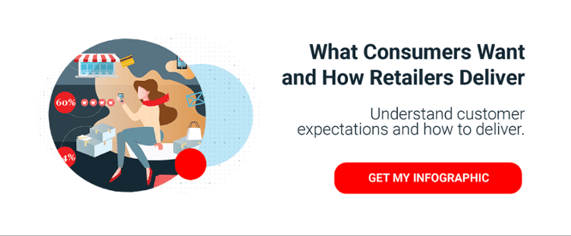Omnichannel Order Management: What Exactly is it?

Editor’s Note: This post was originally published in July 2016 and has been updated for freshness, accuracy, and comprehensiveness.
Omnichannel Order Management – what is it in the context of ‘The Age of the Customer’? Even though we are in ‘The Age of the Customer’ we still see and hear of retailers not providing the right brand experience across channels. Channels like online and bricks & mortar stores all need to provide the same brand experience. If you are not careful, poor experiences can lead to hyper-abandonment by your clients. Omnichannel order management are the systems that help make sure your customer purchases are efficiently and effectively handled, delivered, or prepared for pick up. It is the starting point to help retailers make their businesses hum in the omnichannel space.
The ominous lesson is that failing to adapt to your customers’ wants can be disastrous. This is true even in a growing business segment. Think of social media as an example. Take a look at MySpace. What happened to their growth trajectory when they would not adapt to their user base? Similarly, omnichannel retail is growing fast. Adapt to your customers’ needs, and stay ahead of this growth curve.
Flexibility is Key
Simple OMS is NOT Enough. Two years ago I sat in on an analyst call and it was clear to me that many retailers are buying expensive Order Management Systems (OMS) that just are not working out. This still seems to be the case today. In fact, some systems put serious limitations on retail operations. Other systems limit the brand experience the customer goes through. All this because of a continued lack of flexibility.
An omnichannel order management system can have a major impact on your business if it isn’t the right solution. It can be positive or negative, depending on the solution you choose. Think about the system flexibility, features, and ability to adapt to your business – from day one. That’s why it is so important to look for an omnichannel order management solution that is focused, feature rich, AND that can flex to the changes in your operation.
Is Ship-to-Store All I Need?
Can ship-to-store help? There are many OMS vendors that provide “ship-to-store” solutions. Question is, does this really help my customers today? If you are thinking about this path, consider:
- Once the products arrive at my store, where will they go?
- What are my fulfillment options?
- How will my staff fulfill the order when the client comes looking for it?
- What if the customer does not show up to ‘click & collect’?
- What if the customer shows up but no longer wants the product?
A tip I often share is to be careful of creating an omnichannel strategy with only a ‘ship-to-store’ perspective. Doing this can increase your costs. It might even create confusion in store. A solid omnichannel order management solution should have intelligent, flexible order routing. These capabilities should not limit your options. It has to support how YOU want to operate.
As an example, look at how the solution will help you ship-from-manufacturer to a specific location. Or, what will it do if the distance to a customer is over a certain amount? In this case, will the OMS ship from the Distribution Center (DC) instead? Naturally, there can be any number of scenarios your omnichannel order management engine needs handle. But, don’t forget that it also has to be easy to set up. Your people need to be able to create and modify rules quickly. The system has to be easy enough to let a system administrator do this within a seconds. You can’t rely on a coder to do this for you. After all, as a retailer, it is you who should direct how the order routing needs to happen.
Will Order Routing Help me? Do I REALLY Need it?
Order routing should do a couple of things for your business. First it should cut your shipping costs. Second, you want a system that not only lets you meet customer expectations but also improve your customers’ satisfaction. This is done by getting their purchase to them faster. That’s where really good order routing kicks in.
Best Practices With a Ship-to-Store Option
Ask yourself the question: Why do you want the ability for orders to ship-to-store? Think about your customer first. THEN think about your own business needs.
According to our latest research, The Rise of the Click and Collect Superconsumer, 43% of shoppers shop online and deliver to their home or another location. However, Buy Online, Pickup In-Store is a growing trend with 16% of consumers already preferring this shopping method. Which means if you give the customer the choice to pick up from a nearby store, make it a seamless value-added experience. They get the immediate satisfaction of having the product they bought, with no shipping costs. Find a way to give them even more value with a promotional price on their next purchase. In the case of electronics, or Do-It-Yourself (DIY) goods, give them a few pointers while in store. Have an experienced sales rep give them a quick lesson on using the product. Doing this means the omnichannel experience adds to your brand’s value.
The best part here is that you are providing increase customer satisfaction. They have control. They get their product faster. There are no minimum shipping quantities for a pickup. The system keeps them updated as to their order status – in real-time. For you, the order fulfillment takes place, cost-effectively. You save on shipping costs. They might even buy more items when they are in the store. In fact, 37% of shoppers make additional unplanned purchases when they are in-store to pickup an order. What’s not to love?
Related:Retail Order Management
Store as the DC
You may NOT want to go full ‘open kimono’ on inventory. Some retailers want to use their stores as DCs. With the new omnichannel order management engines this is no longer a new idea. As a retailer, you need to understand the impact of this strategy. It will affect your stores and staff. You will need people who can pick and pack the product. Make it easy for in-store pick, pack and ship with the right system. And you definitely need real-time inventory visibility for your online store. But, you also need to think about setting up safety stock.
Your OMS should let your customers see a certain percent of your in-store products. But you may not want to show all of your inventory. Showing 75% on shelf goods makes sure you don’t sell ALL your hot selling items through online channels. You want some of the hot products to be seen in-store, after all. Remember, that’s what draws customers to your physical stores. Entice your customers to come to your store to shop. They can browse and pick up a few extra items along with that hot seller.
Setting safety stock levels (inventory you don’t show online), lets you reduce your stock-outs. Sure, stock-outs means your products are popular. A good news – bad news story. It might create some good buzz about your brand. Or maybe it throws in a sense of urgency. The downside is that your customer experience also gives your brand a reputation. What you don’t want is the reputation of ‘never having the items customers want.’ Your omnichannel order management system can help make sure the right stock is in a store, as expected.
Store Operations
Another spot where a flexible OMS helps is at the store operations level. It lets you create a ‘great’ experience for your staff and customers. Taking a long-term view and relationship with your vendor can help here. Look at a SaaS (Software as a Service) option. SaaS makes sure the software provider keeps earning the right to do business with you. All vendors are there for you during the sale. But more importantly are they there during the implementation, and to support you long after the project is done? SaaS lets you pick a best-of-breed vendor. It lets you pick the one that integrates perfectly with your eCommerce, warehouse management system (WMS) and other supply chain technologies. Best, it does this with ease.
Buyer Beware
It seems that everybody (POS, Supply Chain, RMS etc.) is creating or has a simple “add-on” OMS. This might seem convenient. But, a very basic or light OMS can limit your operational success. Worse yet, it can hurt your delivery on customer expectations. If you only end up with 25% of the abilities of your nearest competitor, can you still compete effectively? You’re about to make a purchase that impacts the customers’ perception about your brand. Doesn’t it make sense to do it right? Doesn’t it make sense to get the best possible system to push your retail business forward?
OmniChannel Order Management
We started with questioning what is omnichannel order management. Without the technical details, it is the main system that can help you improve and run your omnichannel retail business. It gives you the ability to route orders with rules that can save you money. The system also gives you flexibility on delivery options and speed up deliveries. It can even give you the flexibility of bringing customers into your store for their own pickups. This means changing the way you think about your business. It means changing how your employees service your customers. Best of all, it has the ability to either help your operation with flexibility and ease of use; or it can leave you lagging behind your competition. Chose wrongly, and it can leave you to leak profits, stuck with a system that does not serve customer needs.
When your brand is on the line, take a big picture view. Look for a best-of-breed omnichannel order management system. It will best suit your changing needs. Choose one that turns the tables. Make your competitors feel the heat. Make them have to keep up with you!
Editor’s Note: This post was originally published in July 2016 and has been updated for freshness, accuracy, and comprehensiveness.



